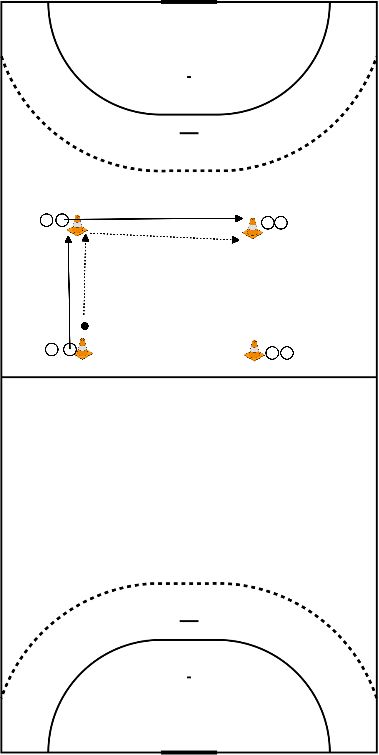Handball drills
- Make pairs of 2 of approximately the same strength/weight
- Place your hand on each other's shoulders and/or upper arm
- After the whistle, try to push your opponent over a predetermined line
- The one who gets the opponent over the line first wins
- After a few times you switch opponents
- Players lined up facing each other
- Hoop between 2 players in the middle
- With 2 hands bounce ball in hoop to other player - feet side by side
- Idem with exit left
- With turn in left shoulder and throw with 1 hand
- Limited space at the circle.
- 1 v 1.
- Try to get past the defender, moving quickly and turning away. Possibly pass and feint movement.
- Explain what is and is not allowed in terms of defense.
- Hands against shoulders. Not from the side.
- Do not hold arms.
- Do not obstruct a broken player.
In F use a small goal.
- Divide the group into two teams.
- The teams stand side by side with about five meters between the players.
- The players of each team stand behind each other, thus forming a line.
- The course of the game is a square.
- Team 1 starts in the far left corner of the square and team 2 starts at the same height in the far right corner of the square.
- Thus, the two teams stand horizontally on the same line.
- At the beginning of the game, the first two players from each team will compete against each other.
Game:
- At the coach's whistle, these 2 players begin to run and follow the lines of the square.
- They will run until they meet on their way.
- At that point they will have to fight for passage!
- This is how you do it:
- You play leaf-stone-scissors.
- Both players hold hands behind their backs and count down together: " 1 , 2 , 3 " and after 3 they each show a symbol:
- leaf: the hand outstretched
- stone: the hand clenched into a fist
- scissors: index finger and middle finger extended
- The leaf overcomes the stone, the stone overcomes the scissors and the scissors win on the leaf.
- Of course, when the same symbol is shown, you have to start counting again.
- The player who wins the leaf-stone-scissors game may continue walking along the lines of the square.
- The loser walks back.
- The goal is to get to the other team as quickly as possible!
- But: when someone loses, the next player from that losing team starts walking until he meets his opponent again.
- Then the leaf-stone-scissors game begins again.
- Thus, the winning player is always stopped until he/she reaches his/her team.
- Divide the group into 2 teams.
- Make an F-Field; width of field.
- Have the groups pass the ball 10x to each other without the other team touching the ball for 1 point. Pass only, do not bounce.
- With an odd group, you can give one player a different vest and they will always play on the team with possession of the ball.
Making it more difficult:
- Do not pass to the same back.
- Everyone must take their turn.
- Ball must not touch the ground.
- Only pass with a bounce.
- You plot a square with the desired distance to fit.
- Each corner has a pawn.
- 1 ball is needed.
- One player starts and throws the ball clockwise to the next corner. Then runs to the next corner chasing the ball.
- This is how the square goes around.
Possible challenges:
- Throwing clockwise and running counterclockwise.
- With 2 balls.
- With 2 balls throwing diagonally and crossing. Beware of other players.
- With bounce.
- With connecting passes to the next corner.

- Narrow space 3 or 4 meters mark between 6 and 12 meters
- 2 defenders with vests stand at the 9 meter mark
- 2 attackers with ball come in pass and go back, and then attack begins.
- Make sure defenders make contact, right shoulder and left first hand over ball.
- Attackers must constantly break free and distance themselves.
- Try passing moves.
- Can be done at the circle in 2, 4 and even 6 stations.
- 2 groups in a row.
- The back player crawls under the next one, jumps over the next one there, crawls under again, etc.
- Out in front: throw again to the last one, and it starts again.
- Whoever crosses the line first.
- Mark! Practice at minidoeltje.
- Coach throws to.
- 0 pass / catch
- Step left -equal to opponent's right foot.
- Big step right -foot sideways - supported by force from left - body turns to right.
- Step left toward 6 yards past opponent.
First tentative break-out exercise.
- 2 players next to the goal, trainer or goalkeeper says go, players start running.
- 1 player is played on, already overplaying to the other side.
- mats - head roll.
- pawns - dribble around.
- ladder - footwork.
- goal - jump shot.
Set out the speed ladder and have players move through the ladder to the beat of the music. Different variations are possible:
- 2 feet out, 2 feet in.
- 2 to the front, 2 to the back.
- Hopping.
- Hopping in zigzag; left of ladder, inside ladder, right of ladder, next compartment of ladder, left of ladder, etc.
- Side jumps. Like a skier.







